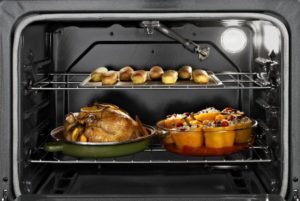How to Troubleshoot Non-Heating Whirlpool Oven
**NOTICE**
Due to the danger and complexity of electronic equipment repair, the following technical tip is intended for professional reference only. Please refer to manufacturer’s recommendations as Encompass does not guarantee the accuracy, reliability or safety of this information.
If it wasn’t for your Whirlpool oven model WFG320M0BW, your family wouldn’t enjoy all those delicious meals you make for them. Unfortunately, the more use your oven gets, the more wear and tear its components endure. One of the most common
oven malfunctions failing to heat. Diagnosing and fixing an oven that is producing little to no heat is a repair you can probably handle on your own. To help you troubleshoot a non-heating oven, here’s a list of components known to affect heating:
Safety Reminder: Always unplug an appliance before starting a repair. If you’re working with a gas oven, turn off the gas supply valve. Always wear work gloves and safety goggles when fixing a malfunctioning appliance.
Check Your Gas Supply
Before inspecting any other components in your oven, test the appliance gas supply. If your oven isn’t receiving gas, it won’t be able to heat up. To check the gas supply, simply turn on a cooktop burner. If the burner ignites, gas is entering the appliance. If the burner stays unlit, pull the range away from the wall to ensure the gas cutoff valve is open. Once you confirm the valve is in the open position, contact your gas provider to find out why no gas is coming from the supply valve.
 Oven Igniter
Oven Igniter
The oven igniter should produce enough heat to open the gas valve and ignite gas entering the appliance. Over time, the igniter can weaken, meaning it will take longer to heat up. If the igniter glows for over a minute without a flame igniting, it’s no longer functioning properly.
How to Replace the Oven Igniter in Your Whirlpool Oven
- Start the repair by removing the lower access panel from the back of the range. Once the panel is off, pull apart the igniter and gas safety valve wire harnesses.
- Open the oven door, and take out the racks. Remove the oven’s lower access panel by lifting the back up first, and then sliding the panel toward the front of the oven.
- The oven igniter is located on the side of the burner tube, which runs through the middle of the oven cavity. To remove the faulty oven igniter, detach the burner tube and take it out. To do so, simply unthread the mounting screws securing it to the inside of the oven. Once the burner tube is free, pull it and the oven igniter out of the oven cavity.
- Place the burner tube on a flat solid surface, and remove the screws securing the defective oven igniter to the burner tube.
- Align the new oven igniter with the mounting bracket on the burner tube. Secure the igniter with screws.
- Go back to the range and reinstall the burner tube. Push the igniter wires through the opening on the oven’s rear wall. Reinsert the oven’s lower access panel, and place the oven racks back in the appliance.
- At the back of the appliance, reconnect the igniter wire harness with the gas safety valve harness. Replace the lower access panel and secure it with the four screws removed earlier.
- Plug the appliance back in, and turn on the gas supply valve. Set oven to preheat and wait for it to warm up to determine if the new oven igniter solved the heating problem.
The Oven Sensor Assembly
The oven sensor and the oven control board work as a team to measure and regulate oven temperature. The sensor detects the temperature inside the oven cavity. If it is defective, the oven will not heat at all or the sensor accuracy will be off by 50 degrees or more.
How to Replace Whirlpool Oven Sensor
- At the back of the oven, disconnect the sensor wire harness. Unthread the two screws securing the oven sensor to the range’s rear panel.
- Once the screws are removed, slide the sensor out of the opening at the back of the oven.
- Insert the new oven sensor into the hole in the rear panel. Replace the mounting screws to hold the sensor in place. Finally, reconnect the wire harness.
- Plug in the range, and turn the gas back on. Test the new sensor by turning the oven on and measuring the temperature inside with an oven thermometer.
Other Contributing Components to Non-Heating Oven Malfunction
The Oven Control Board, as mentioned above, works in conjunction with the oven sensor. While the sensor is more likely to malfunction, the control board can also end up failing. If this happens, the component may inaccurately read the temperature sent from the oven sensor, which can lead to the oven not heating at all or the temperature being significantly wrong. Replacing the defective control board is your best option.
The Gas Safety Valve regulates when gas is and isn’t released into the oven. If the component is working properly, the safety valve will open when the oven igniter begins to glow white hot. A malfunctioning gas safety valve won’t allow gas into the oven, even after the igniter is hot enough to ignite the gas. While a defective safety valve can happen, it is a rare occurrence, meaning you should rule out more common malfunctions first. However, if you do discover the gas safety valve is causing a
non-heating oven, replacing the component is the only way to fix the problem.
Special thanks to Fred’s Appliance Academy for this helpful tip!





Leave a Reply